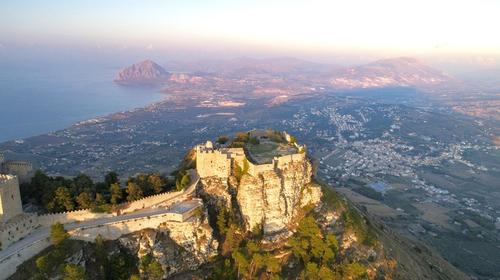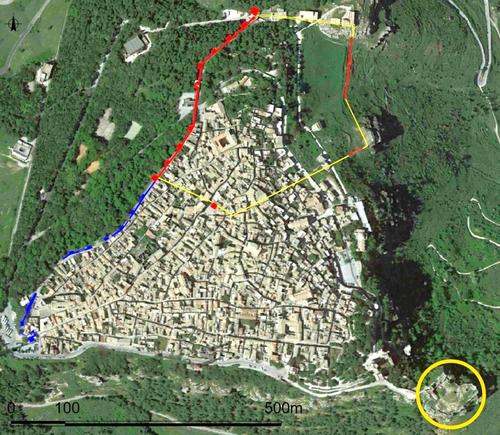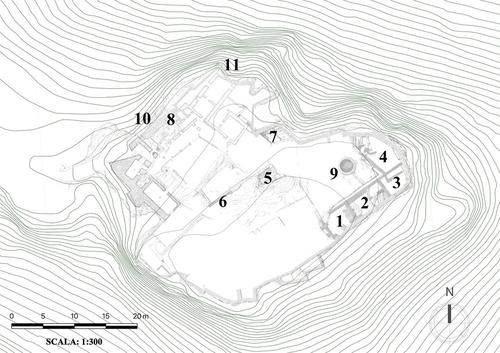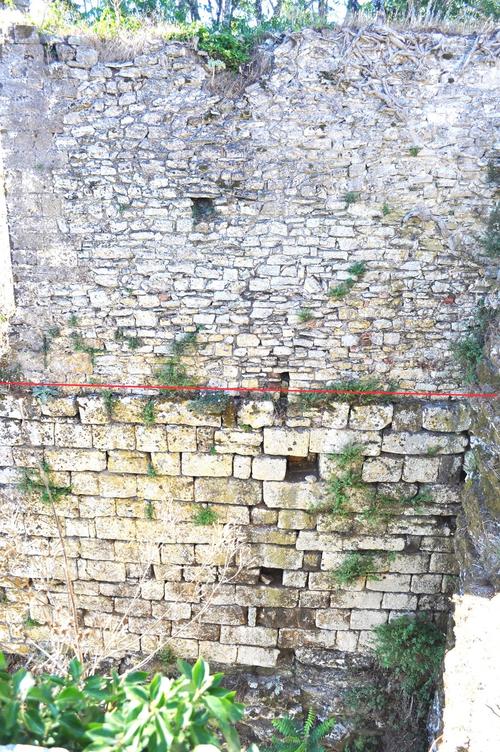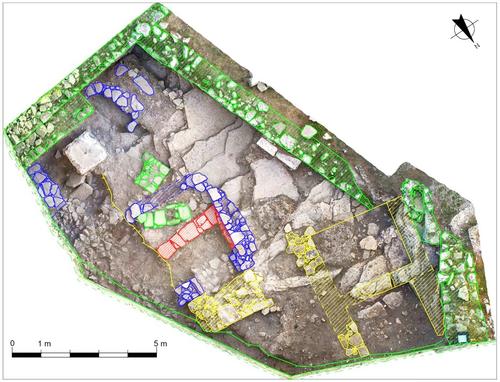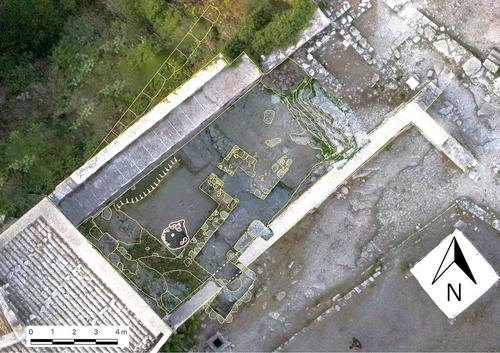Erice: The Sanctuary of Venus Erycina (Sicily)
Fig. 1: The Norman castle of Erice. Oblique UAV photo
Bildquelle: Lorenzo Ceruleo
Fig. 2: Orthophoto of Erice. The extent of the ancient town and the Norman castle (yellow circle)
Bildquelle: De Vincenzo 2016, tav. 3.1
Fig. 3: Plan of the castle and excavations according to Cultrera (1935)
Bildquelle: Blasetti Fantauzzi 2020, 5, fig. 4
Fig. 4: The so-called Wall of Daidalos
Bildquelle: Blasetti Fantauzzi 2020, 4, fig. 3
Fig. 5: Structures found in room δ. Archaic structures in blue and red, Roman structures in yellow, medieval structures in green
Bildquelle: Sabatino Martello
Fig. 6: Structures of the thermal complex
Bildquelle: Sabatino Martello
Funded by the German Research Foundation (2022-2025)
Principle Investigator: PD Dr. Chiara Blasetti Fantauzzi
The aim of the research project is to study the diachronic development of the sanctuary of Venus Erycina at Erice in Western Sicily. The focus is on the analysis of the construction and use phases of the sanctuary as well as the topographical and natural conditions relevant for its development.
Outside Elymian Eryx, between the territories of Phoenicians and Greeks, the goddess Aphrodite/Astarte/Venus was worshipped in the sanctuary at least since the 6th century BC to the 1st century AD. Literary and epigraphic sources attest to both the local and supra-regional importance of the sanctuary. Although, the sanctuary of Venus Erycina holds a special place among the Sicilian sanctuaries, studies on it remain a desideratum of archaeological research. The available results of earlier, mainly historiographic research do not allow any clear conclusions to be drawn about chronological development of the sanctuary (Famà 2010; Barresi 2010; Lietz 2012; Schmitt 2015).
The remains of the sanctuary are located in the courtyard of a Norman castle southeast of the ancient city, on the summit of Mount Eryx (Monte Erice) (fig. 1; fig. 2). This area was the subject of two excavations conducted by G. Cultrera in 1930–1931 (Cultrera 1935) (fig. 2). The first excavated zone concerns the area in the eastern part of the castle. There, along the castle wall, four rooms (α. β, γ, δ) organized in an L-shaped manner along the South and East sides were found (fig. 3: 1-4). The second area where ancient material was found is located in the central area of the castle, on the peak of the hill (fig. 3: 5–6). During the excavations, a series of walls with at least three different construction techniques were found, as well as a levelling layer, that contained exclusively "ancient material" – possibly for the construction of a terrace. Another important zone is located along the northern wall of the castle. In this area, different sections of a wall in opus quadratum were discovered along the castle wall (length between 7 and 11m, estimated height between 3m and 5m) (fig. 3: 7, 10–11). They most likely served as substructures. Among them is the so-called Wall of Daidalos (fig. 4). Along the north-western wall of the castle, a series of rooms with suspensurae and partially mosaic floors have been excavated, indicating a thermal complex (fig. 3: 8).
The report of Cultrera (1935) remains vague on many points. He focused mainly on the central part of the hill, where today all ancient walls are irreversibly destroyed. He did not investigate the eastern area further, but only excavated the medieval layers and the enclosing walls of rooms α-δ. A dating of these rooms was not possible so far and their function is not yet clear. Furthermore, the discovered monumental ancient structures have not yet been studied in detail. The area on the inner side of the so-called Wall of Daidalos has been only partially excavated so far, without reaching the foundations and making it possible to date the structure. The ground plan of the thermal complex as well as its chronology, which would be of great importance for the overall context, remain equally unclear.
Within the framework of this three-year project, the aim is to significantly improve the state of knowledge about the sanctuary of Venus Erycina and its chronology by new, targeted excavations as well as a comprehensive architectural survey. A new plan with all known remains which will be dated through the excavations, as well as all structures which will be revealed by the new excavations, will serve as a basis to prepare substantiated phase plans for the first time. In addition, a central focus is on the landscape and environmental characteristics in the vicinity of the sanctuary as well as the use of resources, in particular water, in order to clarify their significance for the development of the sanctuary.
By generating and analysing new data on the sanctuary of Venus Erycina and by reconstructing its development from the archaic to the early Imperial period, this project will provide the basis for further research on the socio-historical significance of the sanctuary, on the cultural exchange between Elymians, Greeks, Carthaginians and Romans as well as the treatment of allochthonous deities in general.
Preliminary work
Fieldwork in 2018 and 2021 revealed a previously unknown Late Archaic and an important Roman phase of the sanctuary. First trial trenches were carried out in 2018 in the area of the castle in collaboration with the Università degli Studi della Tuscia (Viterbo), in order to analyse the state of preservation of parts of the structures documented by Cultrera (1935) and to allow dating (Blasetti Fantauzzi 2020; Blasetti Fantauzzi 2022). The excavation campaign focused primarily on the eastern area of the inner courtyard of the castle and on the area designated by Cultera as Room δ (fig. 3: 4).
Beneath the medieval floor documented by Cultrera in Room δ, a 1.3m wide Late Republican double-faced wall with a core of rubble and mortar was found (fig. 5). The considerable amount of Roman pottery (Italic terra sigillata, lamps, common ware) found in this area proves that a large area was still being used in Roman times. The wall probably served as the substructure of a monumental terrace. The Roman wall was built on top of rectangular structures associated with Late Archaic material that were not excavated by Cultrera. These structures show the same construction technique as those attributed to the Late Archaic village below the first phase of the city wall (Blasetti Fantauzzi 2018, 18–26). In addition, some statuettes (e.g., votive terracotta, enthroned female figures) were found, as well as a large quantity of black- and red-figure pottery. Thus, these finds support the hypothesis that the sanctuary existed since the Late Archaic period. In addition, common ware and Greco-Italic amphorae were found that can be dated to the period from the mid-4th century BC to the beginning of the 2nd century BC, as well as lekythoi, lamps, unguentaria, and loom weights.
The surface layers (about 40 cm) of the western area were removed in a short two weeks campaign in the summer of 2021, exposing the rooms of the thermal complex, which allowed the delineation of the rooms and provided the basis for an excavation to date the floor and the structure (fig. 6). The largest amount of material mainly dates from the late Republican period. It is mostly amphorae.
The findings from this preliminary work on the Venus Erycina sanctuary are promising. The campaigns allowed to identify new structures and stratigraphic relationships that were not affected by the excavations of Cultrera or by the construction of the Norman castle and are still in situ. At the same time, further potential areas of investigation were identified, on which the next excavation campaigns will focus. This concerns in particular room γ (fig. 3: 3) and the foundation of the so-called Wall of Daidalos (fig. 3: 7). In addition, the eastern foundation wall of the preserved thermal bath complex was identified as another ideal study area, where a dating of the thermal baths would be possible on the basis of excavations (Fig. 3: 8).
References
Barresi 2010: P. Barresi, Il culto di Venere ad Erice in età romana: le testimonianze archeologiche, in: E. Acquaro, A. Filippi, S. Medas (eds.), La devozione dei naviganti. Il culto di Afrodite Erycina nel Mediterraneo. Atti del convegno di Erice, 27-28 novembre 2009 (Lugano 2010) 161–171.
Blasetti Fantauzzi 2018: C. Blasetti Fantauzzi, Tra Elimi e Greci. La ceramica di età arcaica dai contesti di fondazione della cinta muraria di Erice (Roma 2018).
Blasetti Fantauzzi 2020: C. Blasetti Fantauzzi, Il santuario di Venere Ericina. Primi risultati delle indagini nel castello normanno di Erice, FOLD&R. The Journal of Fasti-Online 474, 2020 http://www.fastionline.org/docs/FOLDER-it-2020-474.pdf.
Blasetti Fantauzzi 2022: C. Blasetti Fantauzzi, Erice in età arcaica. Interazioni culturali tra popolazioni locali e Greci, in: C. Colombi – V. Parisi – O. Dally – M. A. Guggisberg – G. Piras (eds.), Comparing Greek Colonies. Mobility and Settlement Consolidation from Southern Italy to the Black Sea (8th – 6th Century BC). Proceedings of the International Conference, Rome, 7.–9.11.2018 (Berlin/Boston 2022) 322–334.
Cultrera 1935: G. Cultrera, Il temenos di Afrodite Erycina e gli scavi del 1930 e del 1931, NSc 13, 1935, 294–328.
Famà 2010: M.L. Famà, Su alcuni materiali di Erice nelle Collezioni archeologiche del Museo Regionale “A. Pepoli” di Trapani, in E. Acquaro – A. Filippi – S. Medas (eds.), La devozione dei naviganti. Il culto di Afrodite Erycina nel Mediterraneo. Atti del convegno di Erice, 27-28 novembre 2009 (Lugano 2010) 49–62.
Lietz 2012: B. Lietz, La dea di Erice e la sua diffusione nel Mediterraneo. Un culto tra Fenici, Greci e Romani (Pisa 2012).
Schmitt 2015: C. Schmitt, Die Göttin auf dem Berg Eryx: Astarte – Aphrodite – Venus, in: L.-M. Günther – B. Morstadt (eds.), Phönizische, griechische und römische Göttinen im historischen Wandel (Turnhout 2015) 109–136.

